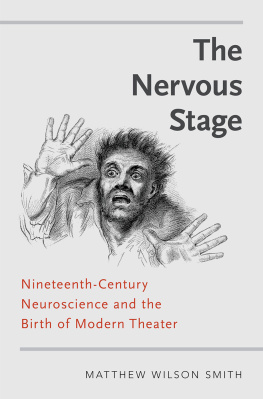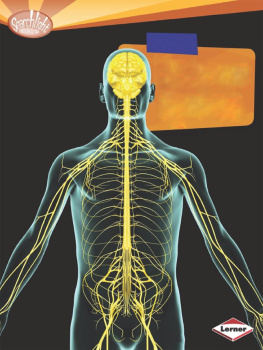THE NERVOUS STAGE

Oxford University Press is a department of the University of Oxford. It furthers the Universitys objective of excellence in research, scholarship, and education by publishing worldwide. Oxford is a registered trade mark of Oxford University Press in the UK and certain other countries.
Published in the United States of America by Oxford University Press
198 Madison Avenue, New York, NY 10016, United States of America.
Oxford University Press 2018
All rights reserved. No part of this publication may be reproduced, stored in a retrieval system, or transmitted, in any form or by any means, without the prior permission in writing of Oxford University Press, or as expressly permitted by law, by license, or under terms agreed with the appropriate reproduction rights organization. Inquiries concerning reproduction outside the scope of the above should be sent to the Rights Department, Oxford University Press, at the address above.
You must not circulate this work in any other form and you must impose this same condition on any acquirer.
CIP data is on file at the Library of Congress
ISBN 9780190644086
eISBN 9780190644109
For Bernie
Contents
THIS BOOK OWES a great deal to conversations over the past few years with friends and colleagues, including memorable exchanges with Alan Ackerman, Richard Begam, Matthew Buckley, Amanda Claybaugh, Mara de Gennaro, Elin Diamond, Martin Puchner, John Paul Riquelme, Laurence Senelick, Henry Turner, and Rebecca Walkowitz.
Special thanks are due to the two readers of the submitted manuscript who chose to reveal their identities. The sharp eyes and wise counsel of these two readers, Alan Richardson and Laurence Senelick, were a great benefit to the completed book. I am also grateful for the third, anonymous, reader for his or her learned response to my work.
The high intellectual bar set by my Stanford colleagues is a regular challenge and inspiration. I have benefitted from the support of too many to mention here, and so will limit myself to thanking those whose reflections directly contributed to my work on this book. These include Russell Berman, Adrian Daub, Dan Edelstein, Amir Eshel, Sepp Gumbrecht, Leslie Hill, Branislav Jakovljevic, Charles Kronengold, Josh Landy, Jisha Menon, and Carol Vernalis. Beyond these, I would like to thank all of my colleagues in the Division of Literatures, Cultures, and Languages and in the Department of Theater and Performance Studies for their ongoing support.
This book was also ably served by four exceptionally sharp graduate students. Kellen Hoxworth, Jessi Piggott, and Matthew Stone read drafts of the manuscript and gave enormously helpful notes, while Biliana Kassabova supplied further aid to individual chapters. One of the greatest pleasures of teaching at Stanford is the opportunity to work with graduate students such as these. Further thanks go to those students who took my seminar on The Nervous Age; their responses to the discourse of nerves in the nineteenth century forced me to separate the wheat from the chaff of my own thoughts. I look forward to this book being surpassed in coming years by their own contributions.
My research into the scientific and artistic work of Georg Bchner provided the initial impetus for this book, and I did much of that research during a sabbatical provided to me by Boston University. I am thankful to BU for this opportunity, and beyond that am grateful to my wonderful friends and colleagues in the English Department at BU for their intellectual guidance and support. Other parts of this book were researched and written during my year as a Fellow at the Society for the Humanities at Cornell University, a fellowship that provided me not only with the time to research and write but also the companionship to grow my ideas in the company of others. I would like to take this opportunity to thank the other Fellows for their criticism and encouragement, and especially to thank the Societys director, Tim Murray.
Parts of this book were first aired as conference papers or invited talks, and three such events proved particularly significant for the development of the project. Back in 2011, the Modernism Seminar at Harvards Mahindra Humanities Center was generous enough to host a discussion of the early work that would ultimately lead to this book, and I am especially grateful to Martin Puchner and John Paul Riquelme for the pleasure of that gathering. In 2013, the Bchner Heute conference at the University of London gave me the opportunity to explore some of my thoughts on Bchners theater of sensation, and I am grateful for the responses that my keynote received. Special thanks go to the conference organizers, Ernest Schonfield, Daniel Steuer, and Godela Weiss-Sussex. I am similarly grateful to the Max Kade Center for European and German Studies at Vanderbilt University, which provided me with a forum to present my research and to enter into conversation with Mark Wallace of the Vanderbilt Brain Institute. Joy Calico and Lutz Koepnick were vital to the success of that memorable event, and I thank them.
Parts of appeared in my essay Laughing at the Redeemer: Kundry and the Paradox of Parsifal in Modernist Cultures (Winter 2007) as well as in a chapter of Modernism and Opera (Baltimore: Johns Hopkins UP, 2016). These are reprinted here by permission of Edinburgh University Press Limited (via PLSClear) and Johns Hopkins University Press, respectively.
Finally, I dedicate this book to Bernadette Meyler. As we have moved across the map from Princeton to Boston to Ithaca to Stanford, and as our family has grown from two to three to four, Bernie has remained my travel companion, my sounding board, my anchor, and my inspiration. This book is the fruit of our many conversations over the past few years, and serves, I hope, as a token of my gratitude and love.
THIS BOOK DRAWS from sources in a number of languages, and when I have found acceptable translations I have used them. While it would prove unwieldy to include the original texts alongside all the translations, I have occasionally included original-language phrases in parentheses when doing so seemed helpful or illuminating. Where no published translation is indicated, the translations are my own.
THE NERVOUS STAGE
It is starting to look as though functional-MRI, EEG, and transcranial-magnetic-stimulation scans might come to know us better than we know ourselves, and that psychopharmaceuticals might provide ever more potent abilities to fundamentally reprogram the psyche. Again, how did we get here?
The answer this book gives is a history of the neural subject. That is: a history of a subject understood as primarily and essentially a nervous system, or, more specifically, a brain. Could my brain be transplanted into another body; could it be placed a vat; could it be decoded and recoded, transformed into a data stream, and uploaded into a digital cloud? When neuroscientists and philosophers, when popular magazines and everyday people start to answer yes to these questionseven more, when yes becomes an assumed backdrop to all sorts of unacknowledged behaviors, structures, and ways of thinkingthen we have entered a new discourse of personhood.
One might well imagine that this is a rather recent phenomenon, maybe arising alongside the term neuroscience itself, a word coined only in 1963. Or perhaps we could go back further in time, to, say, 1938, a year that saw the publication of B. F. Skinners











